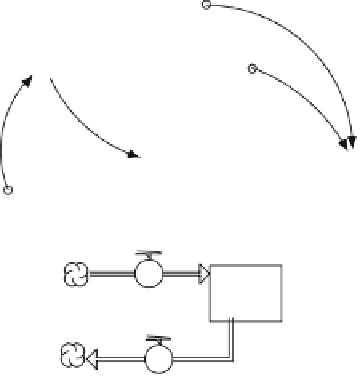Database Reference
In-Depth Information
Rain Event
Low
High
Raining
Drying
Standing Water
Min Temp Range
Events
Cum Precip
Dump
Fig. 5.2
The variable Annual Temp Cycle uses the STELLA built-in SINEWAVE function
to reflect seasonality. This SINEWAVE function was adjusted to produce a max-
imum temperature on Julian Date 228 (Aug. 16) and a minimum on JD 45 (Feb.
14). The temperature range for the year is set at +/- 50 degrees F. The high and low
temperatures, set independently from normal distributions, were: high = the aver-
agedailytemperature+1.5*astandard deviation and low subtracting 1.5 * the
same standard deviation from the mean. This method gave a variable but realistic
temperature variation for Illinois.
Standing water is necessary for mosquito production. We include both rain events
and evapotranspiration in the model as functions of the high and low temperature
(Figure 5.2). We assume there is no probability of rain occurring when the difference
between the high and low temperatures is greater than some threshold. We set that
threshold at 8 degrees. If the daily temperature difference is below 8 degrees F, we
choose a rain event from a normal distribution with an average of 0.8 inches of rain
and a standard deviation of 0.4 inches. We find this result to be compatible with
rain events in Illinois. Precipitation is accumulated to provide standing water, and
standing water is removed from the system using a simple drying equation (Average
Daily Temperature / 75 degrees) mimicking evaporation.
While the model allows for development of three species with different devel-
opmental thresholds, we implemented only one species (the third, indicated by the
number 3 in the variable names) in the transmission cycle for this presentation with
cool season development beginning at 50 degrees F. The corresponding module is
showninFigure5.3.
Daily degree-day accumulations are used to schedule mosquito development
when standing water is present. The mosquito population is divided into three age
classes (eggs, larvae, and adults), and all have the same developmental temperature










